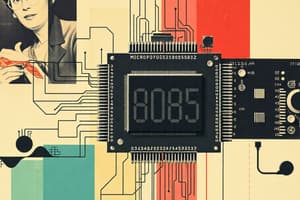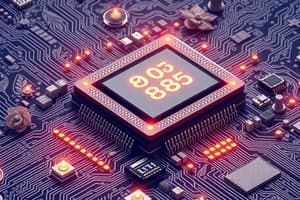Podcast
Questions and Answers
What is the primary advantage of the 8085 microprocessor over its predecessor 8080?
What is the primary advantage of the 8085 microprocessor over its predecessor 8080?
- Higher operational clock speed
- Ability to perform 16-bit operations
- Ability to address up to 64KB (correct)
- Advanced interrupt handling mechanism
Which of the following is NOT a feature of the 8085 microprocessor?
Which of the following is NOT a feature of the 8085 microprocessor?
- It has a 16-bit address bus (correct)
- It is compatible with NMOS technology
- It requires a +5V power supply
- It operates at 3.2 MHz single-phase CLK
In the context of 8085 microprocessor operations, what does the term 'Machine Cycles' refer to?
In the context of 8085 microprocessor operations, what does the term 'Machine Cycles' refer to?
- The states of memory access during data transfer processes
- The various types of bus transfers occurring in microprocessor tasks
- The duration of time a microprocessor takes to execute a particular command (correct)
- The sequence of operations a processor performs in a single instruction
Which component is specifically used for interfacing programmable devices with the 8085 microprocessor?
Which component is specifically used for interfacing programmable devices with the 8085 microprocessor?
What is the maximum addressing capability of 8085 microprocessor?
What is the maximum addressing capability of 8085 microprocessor?
What type of data bus does the 8085 microprocessor utilize?
What type of data bus does the 8085 microprocessor utilize?
Which of the following instructions are NOT part of the instruction set of 8051 microcontroller?
Which of the following instructions are NOT part of the instruction set of 8051 microcontroller?
What distinguishes the usage of Memory Mapped I/O from I/O Mapped I/O in the context of the 8085?
What distinguishes the usage of Memory Mapped I/O from I/O Mapped I/O in the context of the 8085?
Which interrupt has the highest priority in the 8085 microprocessor?
Which interrupt has the highest priority in the 8085 microprocessor?
What type of addressing mode involves providing the operand explicitly within the instruction?
What type of addressing mode involves providing the operand explicitly within the instruction?
Which of the following is NOT a type of machine cycle in the Intel 8085 microprocessor?
Which of the following is NOT a type of machine cycle in the Intel 8085 microprocessor?
Which signal condition does the microprocessor verify while executing an instruction when INTR = 1?
Which signal condition does the microprocessor verify while executing an instruction when INTR = 1?
Which of the following applications is NOT typically associated with the 8085 microprocessor?
Which of the following applications is NOT typically associated with the 8085 microprocessor?
What does the execution of the RST 6.5 interrupt entail in the 8085 microprocessor?
What does the execution of the RST 6.5 interrupt entail in the 8085 microprocessor?
Which of the following bus timings identifies the stable period of the address during a machine cycle?
Which of the following bus timings identifies the stable period of the address during a machine cycle?
What will happen to the INTR signal when the microprocessor is in RESET state?
What will happen to the INTR signal when the microprocessor is in RESET state?
Which addressing mode is characterized by the address of the operand being placed in a register?
Which addressing mode is characterized by the address of the operand being placed in a register?
Which of the following control signals does NOT manage the direction of data flow in the 8085 microprocessor?
Which of the following control signals does NOT manage the direction of data flow in the 8085 microprocessor?
In which application is the 8085 microprocessor NOT commonly used?
In which application is the 8085 microprocessor NOT commonly used?
Which machine cycle is responsible for fetching data from memory for processing?
Which machine cycle is responsible for fetching data from memory for processing?
What is the primary function of the SID and SOD signals in the 8085 microprocessor?
What is the primary function of the SID and SOD signals in the 8085 microprocessor?
Which component of the 8085 microprocessor is primarily responsible for managing data flow and execution of instructions?
Which component of the 8085 microprocessor is primarily responsible for managing data flow and execution of instructions?
What is the main role of the Flag Register in the 8085 microprocessor?
What is the main role of the Flag Register in the 8085 microprocessor?
What operation does the Adder component of the ALU in the 8085 perform?
What operation does the Adder component of the ALU in the 8085 perform?
Which of the following registers in the 8085 is specifically used for addressing memory locations?
Which of the following registers in the 8085 is specifically used for addressing memory locations?
What is the function of the Address Bus in the 8085 microprocessor architecture?
What is the function of the Address Bus in the 8085 microprocessor architecture?
Which signal indicates that the data bus is ready to send data during an operation in the 8085 microprocessor?
Which signal indicates that the data bus is ready to send data during an operation in the 8085 microprocessor?
In the context of the 8085 microprocessor, what does the acronym 'PSW' stand for?
In the context of the 8085 microprocessor, what does the acronym 'PSW' stand for?
What is the bit-length of the registers BC, DE, and HL when paired for 16-bit operations in the 8085 microprocessor?
What is the bit-length of the registers BC, DE, and HL when paired for 16-bit operations in the 8085 microprocessor?
Which component within the 8085 architecture performs operations such as rotate left and shift right?
Which component within the 8085 architecture performs operations such as rotate left and shift right?
Which of the following describes how the 8085 microprocessor communicates internally with I/O devices?
Which of the following describes how the 8085 microprocessor communicates internally with I/O devices?
How does the 8085 microprocessor handle power supply requirements?
How does the 8085 microprocessor handle power supply requirements?
Which of the following is NOT a type of interrupt signal used by the 8085?
Which of the following is NOT a type of interrupt signal used by the 8085?
During the reset state of the 8085 microprocessor, what is the initial value of the Program Counter (PC)?
During the reset state of the 8085 microprocessor, what is the initial value of the Program Counter (PC)?
What function do the HOLD and HLDA signals serve in the 8085 microprocessor?
What function do the HOLD and HLDA signals serve in the 8085 microprocessor?
Flashcards are hidden until you start studying
Study Notes
8085 Microprocessor Architecture
- Developed by Intel in 1977, it is an 8-bit microprocessor capable of addressing 64KB of memory.
- Utilizes NMOS technology and operates on a single +5V power supply with a 3.2 MHz clock speed.
- Consists of an 8-bit ALU, providing arithmetic and logical operations.
- Its architecture includes units like ALU, Timing and Control unit, Interrupt Control, Serial I/O Control, registers, and the CPU as its core.
ALU
- Performs arithmetic operations like addition, subtraction, increment, decrement, and logical operations like AND, OR.
- Its word length is determined by its internal data bus, which is 8-bits in the 8085.
- Contains components like Adder, Shifter and Status register.
Timing and Control Unit
- Responsible for generating control signals for various operations like memory and I/O management.
- Provides timing, control, and status signals, orchestrating communication between the CPU, memory, and peripheral devices.
System Bus
- 8085 communicates with memory and I/O devices via the Address bus, Data bus, and Control bus.
- Data Bus: Bi-directional, carries instructions and data between microprocessor and memory. Its size denotes the type of arithmetic operation possible.
- Address Bus: Unidirectional, transmits instructions from the microprocessor to memory. Its size determines the memory capacity the 8085 can address.
- Control Bus: Includes unidirectional and bi-directional signals, responsible for synchronizing and coordinating operations between the microprocessor and peripheral devices.
Registers
- 8085 has six 8-bit general-purpose registers: B, C, D, E, H, and L. These can be paired to form 16-bit registers BC, DE, and HL for performing 16-bit operations.
- Accumulator: An 8-bit register in the ALU, stores data and the results of arithmetic and logical operations.
- Flag Register (Status Register): Consists of 5 flags (CF, PF, ZF, SF, AC), used to analyze the result of operations. The combined accumulator and flag register is called the Program Status Word (PSW).
- Stack Pointer: A 16-bit register used as a memory pointer, pointing to the memory location used for stack operations.
- Program Counter: A 16-bit register that holds the address of the next instruction to be fetched and executed.
- Instruction Register/Decoder: Temporarily stores the current instruction from memory, decodes it, and sends the decoded data to the CPU.
8085 Microprocessor Pin Diagram
- Utilizes combined Address/Data bus pins (A0-A15) for unidirectional signal transmission from the microprocessor to peripheral devices.
- ALE (Address Latch Enable) signal activates the lower 8 bits of the data bus during the initial T state of the machine cycle.
- S0 and S1 are status signals, determining the operation (read, write, halt, fetch) based on their 4 possible combinations.
8085 Addressing Modes
- Different ways to specify operands for instructions.
- Direct Addressing Mode: Directly specifies the memory location of the operand.
- Register Addressing Mode: Operands are stored in registers (like B, C, D, E, H, L, Accumulator).
- Immediate Addressing Mode: The value of the operand is directly encoded within the instruction.
- Indirect Addressing Mode: The address of the operand is stored in a register pair (BC, DE, HL).
- Implicit Addressing Mode: Operand is implied by the instruction itself, such as the Accumulator in some instructions.
Interrupts in 8085
- Signals triggered by external devices, allowing the microprocessor to deviate from its normal program execution.
- 8085 has 5 hardware interrupt signals:
- TRAP: A non-maskable interrupt with the highest priority. Executes the ISR located at 0024H address.
- RST 7.5: A maskable interrupt with the 2nd highest priority, executing ISR at 003CH address.
- RST 6.5: A maskable interrupt with the 3rd highest priority, executing ISR at 0034H address.
- RST 5.5: A maskable interrupt, executing ISR at 002CH address.
- INTR: A maskable interrupt with the lowest priority. It is enabled during the RESET state.
8085 Applications
- Instrumentation Domain: Used in digital kiosks, security systems, function generators, credit card systems, medical devices, and control panels (like printing presses).
- Entertainment Industry: Implemented in gaming consoles, DVD players, and other electronic devices.
- Communication Systems: Used in digital phones, satellite communication, telephone exchanges, and television/computer motherboards.
- Home Appliances: Controls appliances like ovens, washing machines, and refrigerators.
Machine Cycles & Bus Timings
-
8085 uses a series of machine cycles for instruction execution, typically consisting of four types:
- Opcode Fetch Cycle: Retrieves the instruction code from memory based on the Program Counter.
- Memory Read Cycle: If the instruction requires data from memory, the microprocessor fetches it.
- Memory Write Cycle: If the instruction stores data back into memory, the microprocessor writes it.
- I/O Read/Write Cycle: Enables data transfer between the microprocessor and I/O devices.
-
Bus timings determine the timing characteristics of data transfer over the system buses, involving:
- Clock Speed: Typically 3 MHz in 8085, defining the rate of instruction processing.
- Cycle Timing: Diagram showing the timing of address, data, and control signals within each machine cycle.
- Control Signals: Manage data flow and operation of memory and I/O devices.
- Memory and I/O Timings: Specifying time constraints for memory and I/O operations.
Studying That Suits You
Use AI to generate personalized quizzes and flashcards to suit your learning preferences.






